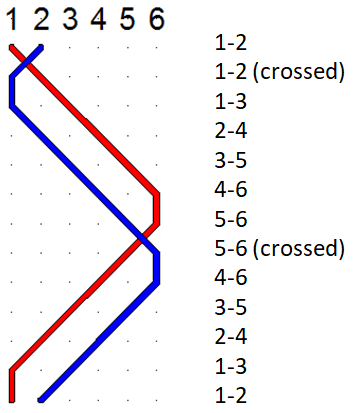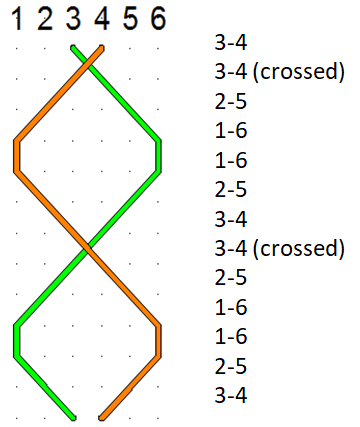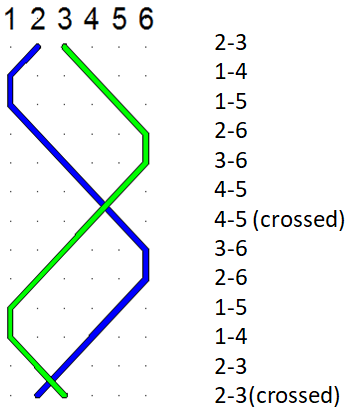Handbell Toolbox
2. Strong foundation skills
2.4. The three minor positions
Now – how can we ring Plain Hunt on handbells? Happily plain hunting two handbells is easier than it sounds. You will learn the three minor positions, which form the basis of all handbell ringing on 6 bells.
Plain Hunt on handbells explained
The first part of this video (up to 2:35) shows the two things you must think about when ringing Plain Hunt on handbells:
- Knowing which bell in your pair rings first in the row.
- Knowing how many bells to strike between this first bell and your second bell.
Plain Hunt on six bells
On six bells there are three patterns for your left and right hands to master. These are called the coursing position, the opposites position and the 2-3 position. The above video introduced you to the coursing position, rung in this instance by the trebles (1-2).
There are two ways of learning the three positions:
- By learning the two places that your bells ring in each row.
- By learning the first place that you ring in a row and the gap you leave before ringing your second bell.
Have a go at both and see which one works better for you.
Be aware that if both bells are hunting in the same direction then the gap between them remains constant. The gap changes by one if one bell is hunting and the other is making a place. The gap between them shrinks by two if they are hunting towards each other, and increases by two every time they hunt in opposite directions.
You can download diagrams of the three minor positions here.
Coursing position

This is the pattern rung by 1-2 and by 5-6. It is the easiest position to learn and ring. Remember:
- Know which hand is closer to the front in every change (blue or red).
- Know what place that hand is striking in.
- Leave a gap and sound the other hand – signature characteristic of a coursing pair – or learn the number pairs by rote.
- Meet and cross in 1/2 and 5/6.
- You start and end by crossing your bells.
You will recognise that the pattern of a gap of a single bell only alters when one of your pair is called upon to lead or lie. When both bells are hunting the gap of one is maintained.
In the first half of the course you must concentrate on the 2, after the reverse rounds at the halfway point you must then concentrate on the treble. Always concentrate on the first of your bells to strike, count its place, leave a gap and sound the other bell.
Watch the trebles (1-2) ring Plain Hunt in this video. Then recite along with the ringing:
- Either the places they ring in – cross, 1/3, 2/4, 3/5, 4/6/ meet, cross, 4/6, 3/5, 2/4, 1/3, meet
- Or the gaps between them – cross, 1 and 1 between, 2 and 1 between, 3 and 1 between, 4 and 1 between, meet, cross, 4 and 1 between, 3 and 1 between, 2 and 1 between, 1 and 1 between, meet.
The tenors (5-6) also ring the coursing position but start in a different place.
Opposites position

This is the pattern rung by 3-4. It is the second easiest position to learn and ring. The pattern is akin to an object and its reflection with a mirror running down the centre. When one bell sounds in 3rd place the other is in 4th (either side of the mirror). When one bell sounds in 2nd place (one away from the front) the other sounds in 5th (one away from the back), when one bell sounds first the other is last.
In the opposites position the bells meet and cross in 3/4.
You need to keep track of which of your pair is closest to the front, what place it is in and then ring the other bell in the appropriate place. If you have counted the first of your bells to be in 2nd place then the other bell must ring in 5th, if however your first bell is in 3rd then the other bell must be in 4th place.
Do not try to keep track of the position of both bells and to hunt them both – rather keep track of the place of the first of your pair to strike and then simply ring the other bell as a reflection of the first.
Remember which bell is closest to the front of your pair (this is the one you are counting) and which is the reflection. Loudly count 3rd (quietly think 4th for the other hand). Loudly count 2nd (quietly think 5th for the other hand). Loudly count 1st (quietly think last for the other hand) etc.
Watch the 3-4 ring Plain Hunt in this video. Then recite along with the ringing:
- Either the places the bells ring in – cross, 2/5, 1/6, 1/6, 2/5 meet, cross, 2/5, 1/6, 1/6, 2/5, meet.
- Or the gaps between them – cross, 2 between you, 3 between you, 3 between you, 2 between you, meet, cross, 2 between you, 3 between you, 3 between you, 2 between you, meet.
The 2/3 position

And finally, you are ready to look at the look at the last of the three positions, the 2/3 position. It does not relate to any of the traditional pairs, 1-2, 3-4 or 5-6 that ringers ring. It is the position rung if a ringer rang the 2-3 or 4-5.
In the 2/3 position, the bells meet and cross in 2/3 and 4/5.
This is the position in which the bells both hunt in the same direction (in which case the gap between them remains constant) AND hunt towards or away from each other (in which case the gap between them shrinks or increases by 2).
Watch the 3-4 ring Plain Hunt in this video. Note however that the ringing does not start or finish with rounds – 1 2 3 4 5 6 – but with the row – 2 3 4 5 6 1 – which means that the person ringing 3-4 starts by striking in 2nd and 3rd place, so they are ringing the 2-3 position. Sounds complicated but you'll get it when you watch the video.
Recite along with the ringing:
- Either the places the bells ring in – cross, 1/4, 1/5, 2/6, 3/6 meet, cross, 3/6 2/6, 1/5, 1/4, meet.
- Or the gaps between them – cross, 2 between you, 3 between you, 3 between you, 2 between you, meet, cross, 2 between you, 3 between you, 3 between you, 2 between you, meet.
Practising the positions
It is important to practise these positions until they become automatic. This requires you to do your homework. Reciting numbers or mantras or twiddling your thumbs whenever you have a spare moment may feel a bit strange, but it works. Online ringing simulators also help as they will introduce you to the rhythm of the different positions. You can find out more about how to practise on your own here.
